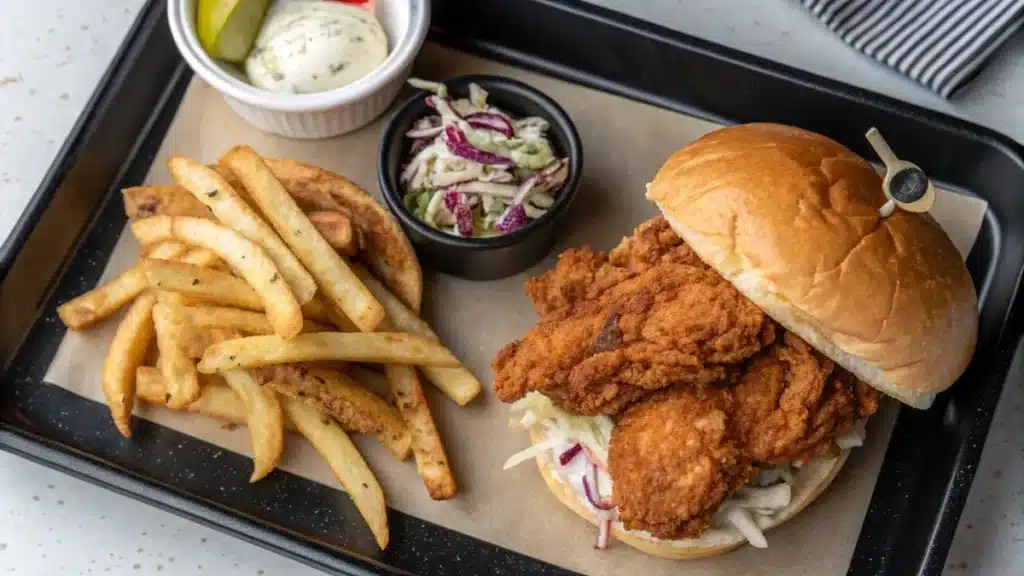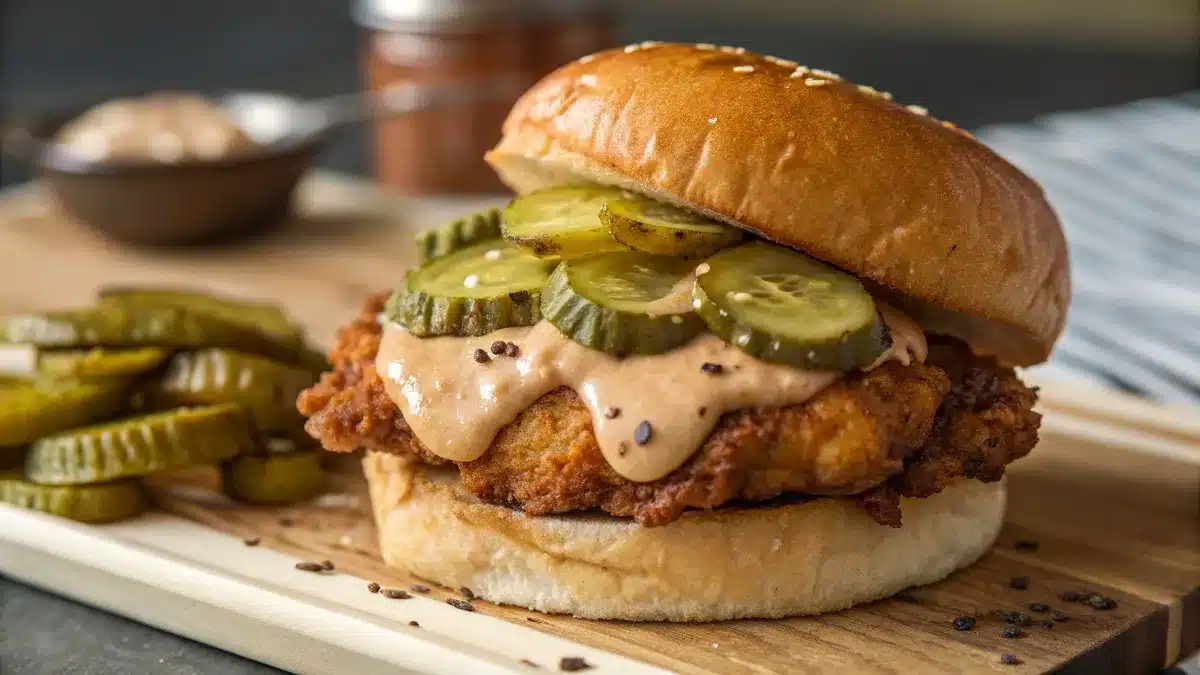The Ultimate Buttermilk Fried Chicken Sandwich Guide (Crispy, Juicy & Irresistible)
Looking to master the ultimate buttermilk fried chicken sandwich at home? Whether you’re after crispy crunch, juicy chicken, or just that classic Southern comfort in every bite, this guide has you covered. From the science behind buttermilk to step-by-step cooking methods, tasty no-buttermilk alternatives, calorie breakdowns, and mouthwatering add-ons, you’ll find everything you need to create the perfect sandwich right in your kitchen.
Learn more about Crack Burger Recipe if you’re a sandwich lover exploring more crave-worthy combos.
Table of Contents
What Is a Buttermilk Fried Chicken Sandwich?
Understanding the Classic Southern Sandwich
The buttermilk fried chicken sandwich is an American comfort food staple. It combines tender chicken marinated in tangy buttermilk, coated in a seasoned flour mixture, then fried until golden and crunchy. Sandwiched between a toasted bun with pickles, lettuce, or slaw, it’s a handheld bite of Southern tradition. This dish rose to national fame thanks to fast-food icons like Popeyes and Chick-fil-A, but the homemade version brings unmatched freshness and flavor.
The key difference between this sandwich and others lies in its preparation. The buttermilk soak is more than a Southern charm — it serves a real culinary purpose, which we’ll explore shortly.
Why Buttermilk Matters: The Secret Behind the Crispy Crust
What sets a buttermilk fried chicken sandwich apart from others is how buttermilk works behind the scenes. It’s slightly acidic, which helps tenderize the meat, and its creamy texture clings to the chicken, holding onto all that seasoned flour for an extra-crunchy shell. That’s why biting into one is a multi-sensory experience — juicy inside, crunchy outside, with a balanced tang you can’t fake.
This isn’t just about flavor — it’s about texture. Buttermilk helps ensure the breading adheres tightly to the chicken, forming a crust that doesn’t fall apart when you take a bite.
What Sets It Apart From Other Chicken Sandwiches
Unlike grilled chicken sandwiches or basic fried versions, this one uses marination plus breading techniques to create depth. Fast food chains may cut corners, but when you make it at home, you’re in control of seasoning, crisp level, oil quality, and toppings.
Want to add heat? Mix cayenne into the flour. Want tang? Add pickled slaw. Want that buttery crunch? Toast those brioche buns. And don’t forget the sauce — from spicy mayo to honey butter.
Don’t miss our Smothered Chicken Recipe for another southern classic dish you’ll love.
Buttermilk Magic – What It Really Does to Chicken
The Role of Buttermilk in Tenderizing Chicken
So, what’s the big deal with buttermilk? When it comes to frying chicken, buttermilk isn’t just a Southern tradition — it’s a science-backed marinade that transforms tough chicken cuts into tender, juicy perfection. Lactic acid helps tenderize the chicken by slowly breaking down its proteins, resulting in a more flavorful, juicy texture. This natural enzymatic reaction leads to a more tender bite without making the meat mushy.
Even just a few hours in a buttermilk bath can work wonders. And unlike citrus-based marinades, buttermilk doesn’t make the chicken rubbery or overly sour. It’s balanced, smooth, and mild — ideal for long marinating times.
Looking for inspiration? Try Slow Cooker Cheesy Mozzarella Chicken if you’re experimenting with tender poultry meals.
How Buttermilk Affects Texture and Flavor
Beyond tenderness, buttermilk is also your secret to a crispier, well-adhered crust. Its slightly thick consistency clings to the surface of the chicken, ensuring your dredge — whether it’s seasoned flour or a breadcrumb mix — binds tightly and stays put during frying. That means no bald spots or patchy breading.
And flavor? Buttermilk brings a tangy undertone to every bite, pairing beautifully with spices like paprika, garlic powder, cayenne, and black pepper. When fried, this combo creates a golden, flavor-packed crust that’s crave-worthy.
Want it spicy? Add a few dashes of hot sauce to the buttermilk for a fiery kick that soaks deep into the chicken. Sweet and spicy? A drizzle of honey in the marinade can add contrast without overwhelming the spice.

Best Marination Times for Optimal Results
How long should you marinate the chicken in buttermilk?
Here’s a simple guide:
| Marination Time | Results |
|---|---|
| 30 minutes | Mild flavor, minimal tenderization |
| 2–4 hours | Balanced flavor, noticeable tenderness |
| 8–12 hours | Deep flavor penetration, optimal texture |
| 24 hours | Maximum flavor, very tender meat (best for thighs or drumsticks) |
Avoid going past 24 hours, especially with lean cuts like chicken breast, as they can become too soft and lose structure.
Check out Garlic Parmesan Chicken Pasta to see how marination improves flavor in creamy dishes too.
Ingredients You Need for the Perfect Buttermilk Fried Chicken Sandwich
Essential Ingredients for the Chicken Marinade
When crafting the best buttermilk fried chicken sandwich, your marinade sets the foundation. Here’s what you’ll need:
- Chicken thighs or breasts – Thighs are juicier, but breasts work for leaner options
- Buttermilk – The hero of the marinade, helping to tenderize and flavor
- Hot sauce – Optional, but adds depth and heat
- Salt – Essential for drawing flavor into the meat
- Garlic powder, onion powder, paprika – Boosts savory notes
- Black pepper – For balance and mild spice
Mix the buttermilk and spices in a large bowl or zip-lock bag. Add chicken, cover, and refrigerate for at least 4 hours (overnight is best). This gives the flavors time to infuse and prepares the meat for perfect frying texture.
Learn more about Chicken Mushroom Masala for another flavorful way to use savory chicken marinades.
The Best Breading Mix for Crunch
The breading is where that iconic crunch comes from. Here’s your ideal combination:
- All-purpose flour – Forms the base of the coating
- Cornstarch – Lightens the flour and adds crispiness
- Seasonings – Salt, pepper, paprika, cayenne, garlic powder, dried herbs
- Baking powder (optional) – Adds an airy texture when fried
Pro tip: After dredging, let the coated chicken rest for 15 minutes before frying. This helps the crust adhere and develop those crackly crags you want in every bite.
Want ultra-crunchy texture? Do a double-dip: back into the buttermilk, then into the flour again.
Buns, Pickles, Sauces, and More – Choosing the Right Add-ons
Now for the build: what goes between those buns matters just as much as the chicken.
- Buns: Brioche buns are the top choice for their slight sweetness and buttery feel. Potato rolls are great alternatives. Toasting is non-negotiable.
- Pickles: Dill pickles add brightness and acidity. Go with thick-cut or crinkle chips.
- Slaw or Lettuce: Optional, but offers crunch and freshness.
- Sauce Options:
- Spicy mayo (mayo + sriracha or hot sauce)
- Honey mustard
- Classic aioli
- Ranch or blue cheese for bold contrast
Want to spice it up? Drizzle a little hot honey right onto the chicken before closing the sandwich.
Don’t miss our Chicken Philly Cheesesteak for more sandwich-building flavor inspiration.
Step-by-Step Guide to Make Buttermilk Fried Chicken Sandwich at Home
Prepping and Marinating the Chicken
The foundation of a perfect buttermilk fried chicken sandwich is well-marinated chicken. Here’s how to prep it for top-tier results:
- Choose your cut – Boneless, skinless chicken thighs give you juicier meat, but chicken breasts work well if pounded to an even thickness.
- Create the marinade – In a large bowl or sealable bag, combine:
- 2 cups buttermilk
- 1 tablespoon hot sauce
- 1 teaspoon each of garlic powder, onion powder, paprika, and salt
- Add chicken and marinate – Submerge the chicken fully and refrigerate for 4–24 hours.
Longer marination = juicier, more flavorful chicken.
Perfecting the Dredge: Tips for Crispy Coating
Once marinated, it’s time to coat your chicken for frying. This is where the magic happens.
Dry Coating Mixture:
- 2 cups all-purpose flour
- ½ cup cornstarch (for crispness)
- 1 teaspoon baking powder
- 1 tsp each: garlic powder, cayenne, salt, black pepper, paprika
Dredging Process:
- Remove chicken from buttermilk (let excess drip off).
- Dredge thoroughly in seasoned flour mixture.
- Optional: Dip chicken back in buttermilk and dredge again for a double-crunch crust.
- Let coated chicken rest for 15 minutes — this step helps the flour bind and prevents it from falling off during frying.

Deep Frying Techniques: Temperature, Tools, and Timing
Let’s fry it up!
- Oil: Use peanut, canola, or vegetable oil with a high smoke point.
- Temperature: Maintain oil at 325°F–350°F using a thermometer.
- Pan or fryer: Use a deep Dutch oven or deep fryer for even cooking.
- Fry time: About 5–7 minutes per side, depending on thickness. Internal temp should be 165°F.
Tips:
- Avoid overcrowding the pan — it drops oil temperature and causes soggy breading.
- Drain fried chicken on a wire rack, not paper towels, to keep it crispy.
Building the Sandwich: From Bottom Bun to Top
Now comes the fun part — assembling your masterpiece.
- Toast the buns – Lightly butter and toast for added crunch and flavor.
- Layering:
- Bottom bun
- Optional: sauce spread (spicy mayo or aioli)
- Fried chicken fillet
- Pickles or slaw
- More sauce if desired
- Top bun
- Secure with a skewer if serving for guests to keep it neat.
Optional upgrade: Drizzle hot honey over the chicken just before adding the top bun for a sweet-heat balance.
Now you’ve got a chicken sandwich that rivals any restaurant or drive-thru — and you made it yourself!
No Buttermilk? No Problem! Substitutes and Alternatives
Top Buttermilk Substitutes That Work
You don’t need to skip making a crispy chicken sandwich just because you’re out of buttermilk. There are plenty of kitchen staples that can mimic its tangy, tenderizing effects.
Here are the best buttermilk alternatives:
| Substitute | Ratio | Why It Works |
|---|---|---|
| Milk + Vinegar | 1 cup milk + 1 tbsp white vinegar | Acid mimics buttermilk’s tenderizing effect |
| Milk + Lemon Juice | 1 cup milk + 1 tbsp lemon juice | Same effect with a citrus twist |
| Plain Yogurt (thinned with water) | ½ cup yogurt + ½ cup water | Creamy texture + natural acidity |
| Sour Cream (thinned) | ½ cup sour cream + ½ cup water or milk | Great for flavor-rich marinades |
| Kefir | Use 1:1 as buttermilk | Fermented, tangy, and perfect for tenderizing |
Let the mixture sit for 5–10 minutes before adding chicken. These combos break down proteins similarly to buttermilk, resulting in flavorful, tender meat.
How to Make a Fried Chicken Sandwich Without Buttermilk
Making a delicious fried chicken sandwich without buttermilk is totally doable. Simply follow the same steps, swapping in any of the suggested alternatives listed above:
- Marinate the chicken in your chosen alternative for 2–4 hours.
- Season your marinade the same way you would buttermilk: salt, paprika, garlic powder, hot sauce, etc.
- Follow the same dredging and frying process outlined in Part 4.
The flavor difference? Slightly less tangy, but still rich and satisfying when seasoned well.
If you’re craving bold and spicy flavor without the dairy, consider using hot sauce mixed with lemon juice and water as a quick brine.
Discover great ideas like Gluten-Free Fettuccine Alfredo if you’re exploring more dairy-free comfort foods.
Flavor Comparison: Buttermilk vs. Non-buttermilk Versions
| Feature | Buttermilk Version | Non-buttermilk Version |
|---|---|---|
| Tenderness | High | Moderate to high (depends on sub) |
| Tanginess | Classic Southern tang | Varies (citrus is brighter, yogurt is rich) |
| Crust Adherence | Excellent | Still great if properly dredged |
| Fry Texture | Extra crispy | Comparable with good flour ratio |
No buttermilk? No stress. With a few smart substitutions, you can still deliver a crispy chicken sandwich your tastebuds will cheer for.
Fried Chicken Breast Sandwich Variations
Using Chicken Breast Instead of Thighs: Pros and Cons
While thighs are typically juicier due to higher fat content, many prefer the leaner, cleaner flavor of chicken breasts — especially for lighter sandwiches or when aiming for lower calorie meals.
Pros of Chicken Breasts:
- Leaner, lower in calories
- Larger, easier to portion
- Great canvas for strong seasonings
Cons:
- Can dry out if overcooked
- Needs pounding for even frying
- Less forgiving than thighs during frying
Tip: To prevent dryness, pound the breast to a ½-inch thickness and marinate it for at least 4 hours. For extra insurance, use a digital thermometer to ensure you hit 165°F — not more.
Spicy, Honey, and Nashville Hot Styles
When it comes to flavor, the buttermilk fried chicken sandwich is wildly customizable. Here are three fan-favorite styles:
- Spicy Chicken Sandwich
Add cayenne pepper and hot paprika to both the marinade and dredge. Top with spicy mayo (mayo + sriracha) and jalapeño pickles for heat lovers. - Honey Chicken Sandwich
Drizzle hot honey over the fried chicken before assembling. Pair with slaw and brioche for sweet-savory harmony. - Nashville Hot Chicken Sandwich
After frying, brush the chicken with a mix of hot oil, cayenne, paprika, and brown sugar. Serve on white buns with pickle chips and mayo — no frills, just heat.
These bold flavor tweaks are restaurant-quality and totally DIY-able.
Air-Fried, Oven-Baked, and Pan-Fried Versions
Not a fan of deep frying? No problem. You can still achieve crisp, juicy chicken with these methods:
| Method | Instructions | Pros | Cons |
|---|---|---|---|
| Air Fryer | Spray dredged chicken with oil and cook at 375°F for 15–18 minutes | Lower fat, crispy result | May need flipping and preheating |
| Oven-Baked | Bake on a wire rack at 400°F for 25 minutes | Healthier, batch-friendly | Slightly less crispy |
| Pan-Fried | Fry in shallow oil, 4–5 minutes per side | No deep fryer needed | Can result in uneven browning |
Choose what works for your kitchen — and your comfort level with oil.
Looking for inspiration? Try Delicious Dill Pickle Sandwich if you’re after creative sandwich pairings.
Nutrition & Calories – What You Need to Know
How Many Calories in a Buttermilk Fried Chicken Sandwich?
The calorie count of a buttermilk fried chicken sandwich depends on its size, breading, frying method, toppings, and bun. Here’s an average estimate for a classic homemade sandwich:
| Component | Calories |
|---|---|
| Chicken thigh (fried, breaded) | 350–400 kcal |
| Brioche bun (toasted) | 200 kcal |
| Pickles and lettuce | 10–20 kcal |
| Mayo or spicy sauce | 100–150 kcal |
| Total per sandwich | 660–770 kcal |
If you’re using a larger breast or adding cheese or bacon, the count can easily push past 800 calories.
Want to cut it down? Opt for a whole wheat bun, light mayo, and bake instead of fry.
Comparison: Homemade vs. McDonald’s Version
Let’s compare homemade versions with the fast-food giant McDonald’s for context.
| Sandwich Type | Calories | Sodium | Fat |
|---|---|---|---|
| McDonald’s Buttermilk Crispy Chicken Sandwich | ~620 kcal | 1,070 mg | 29g |
| Homemade (fried) | ~680 kcal | ~900 mg | 30g |
| Homemade (air-fried) | ~540 kcal | ~850 mg | 18g |
So while fast food might be convenient, homemade gives you:
- Better ingredient control
- Option to cut sodium or fat
- Opportunity to choose healthier buns and oils
Tips to Make a Healthier Version Without Sacrificing Taste
Craving the crunch but not the calories? Here’s how to lighten your sandwich:
- Swap frying for baking or air frying
- Use skinless chicken breast to reduce fat
- Replace full-fat mayo with Greek yogurt or mustard
- Use whole grain or thin sandwich buns
- Go light on sauces – flavor with herbs, vinegar, and pickled veggies
- Control portion size – use slider buns for smaller servings
Even minor swaps can shave off 150–200 calories without compromising on flavor.
Don’t miss our Healthy Shredded Chicken ideas for more ways to eat well without sacrificing satisfaction.
Pro Tips and Troubleshooting Common Mistakes
Even with a solid recipe, small missteps can make or break your buttermilk fried chicken sandwich. Here’s how to avoid soggy crusts, dry chicken, and other disappointments.
Why Your Chicken Might Turn Out Soggy
Nothing ruins a buttermilk fried chicken sandwich faster than a limp, soggy crust. Here are the most common culprits:
- Oil too cold: If oil temperature drops below 325°F, the coating absorbs more oil, making it greasy and soft.
- Overcrowding the pan: Too many pieces at once cool the oil and cause steaming rather than frying.
- Not resting the dredged chicken: Letting the flour coating set for 15 minutes before frying helps it adhere and crisp.
- No wire rack: Draining on paper towels traps steam underneath, making the bottom soggy.
Fix it: Always fry in small batches, maintain oil at 350°F, and rest fried chicken on a wire rack for air circulation.
Preventing Overcooking and Dryness
Dry chicken happens when:
- You use chicken breast without pounding it evenly.
- You overcook past 165°F, drying out lean meat.
- You don’t marinate long enough, especially without buttermilk.
Solution:
- Use a meat thermometer to pull the chicken at 160°F (it’ll continue to cook slightly while resting).
- For breasts, pound to even thickness so the middle cooks as fast as the edges.
- Marinate a minimum of 4 hours or overnight.
How to Store and Reheat buttermilk Fried Chicken Sandwiches
If you have leftovers, proper storage is key to maintaining crunch and flavor.
Storage Tips:
- Store chicken and buns separately to avoid sogginess.
- Wrap chicken loosely in foil or place in an airtight container in the fridge (up to 3 days).
Reheating Tips:
- Oven method: Bake at 375°F for 8–10 minutes on a rack.
- Air fryer: 375°F for 4–6 minutes works wonders for crispiness.
- Avoid microwaves — they make breading soggy and meat rubbery.
Reheat only the chicken, then rebuild the sandwich fresh with sauce and toppings.
Check out Crispy Juicy Chicken Cutlets for more techniques that apply to crispy fried chicken.

Serving, Pairing, and Storage Ideas
You’ve mastered the marination, nailed the fry, and stacked the perfect sandwich — but how do you serve it up right? Let’s finish strong with sides, sauces, and leftover tips to elevate your buttermilk fried chicken sandwich experience.
Top Side Dishes to Serve With buttermilk Fried Chicken Sandwiches
Whether you’re planning a backyard cookout or a weeknight dinner, the right side dish turns your sandwich into a full-blown feast.
Classic Pairings:
- French fries or sweet potato fries
- Creamy coleslaw (adds crunch and balance)
- Mac and cheese
- Dill pickle spears
- Onion rings
Fresh Alternatives:
- Cucumber salad with vinegar
- Corn on the cob or elote
- Roasted Brussels sprouts
- Fruit salad or watermelon slices
Want to take it Southern-style? Add baked beans and cornbread muffins.
Best Drinks and Sauces to Pair
Sauce can make or break your sandwich. Here are some ideas to keep it interesting:
Sauce Pairings:
- Spicy mayo (sriracha + mayo + lime juice)
- Ranch or chipotle ranch
- Honey mustard
- Buffalo sauce
- Classic aioli or garlic mayo
Drink Pairings:
- Iced sweet tea
- Homemade lemonade
- Sparkling water with citrus
- Cold beer or cider for casual nights
- Cola or root beer for diner-style vibes
These combos balance the richness of the sandwich with refreshing, contrasting flavors.
How to Store Leftovers and Keep Them Crispy
Leftover fried chicken can stay just as amazing with proper storage and reheating.
Do this:
- Separate chicken from buns and toppings
- Wrap chicken loosely in foil or store in a ventilated container
- Refrigerate for up to 3 days
- Reheat in oven or air fryer (375°F for 6–10 mins) to revive crispness
Don’t:
- Microwave (soggy crust)
- Store built sandwiches fully assembled — the buns will turn mushy
For long-term storage, freeze fried chicken for up to 2 months. Thaw in fridge overnight before reheating.
Conclusion: Bring the Crunch Home With the Best Buttermilk Fried Chicken Sandwich
There’s nothing quite like biting into a buttermilk fried chicken sandwich — crunchy on the outside, juicy on the inside, and packed with rich, Southern-inspired flavor. Whether you’re using classic buttermilk or a smart alternative, frying or baking, thighs or breasts, this sandwich is endlessly customizable and always satisfying.
Now you’ve got everything you need: from ingredients and frying tips to calorie breakdowns, flavor variations, and even storage hacks. Whether you’re cooking for yourself, family, or hosting a backyard bash, this guide ensures your sandwich hits every note — tender, crispy, and unforgettable.
Craving more southern comfort food? Don’t miss our Crack Burger Recipe or level up your dinner game with Smothered Chicken.
FAQs
What does buttermilk do to fried chicken?
Buttermilk tenderizes the chicken by breaking down proteins while adding tangy flavor. Its thick texture helps the flour coating stick, creating a crispier crust.
How to make fried chicken sandwich without buttermilk?
You can substitute buttermilk with milk + vinegar, yogurt + water, or even sour cream. Marinate the chicken, season it well, and follow the same frying steps.
How many calories in buttermilk fried chicken sandwich McDonald’s?
McDonald’s version has around 620–670 calories, depending on toppings and sauce. Homemade versions may be higher or lower based on your choices.
How to make a fried chicken sandwich without buttermilk?
Use milk with lemon juice, thinned yogurt, or hot sauce brine. Let the chicken soak for at least 4 hours to retain moisture and flavor, then bread and fry.
How to make buttermilk fried chicken sandwich?
Marinate chicken in buttermilk and spices, dredge in seasoned flour, deep fry until golden, then layer on toasted buns with pickles, sauce, and toppings.
How to make fried chicken breast sandwich no buttermilk?
Pound chicken breast to even thickness, marinate in yogurt or milk-vinegar mixture, dredge with seasoned flour, and fry. Serve on toasted buns with sauce.

